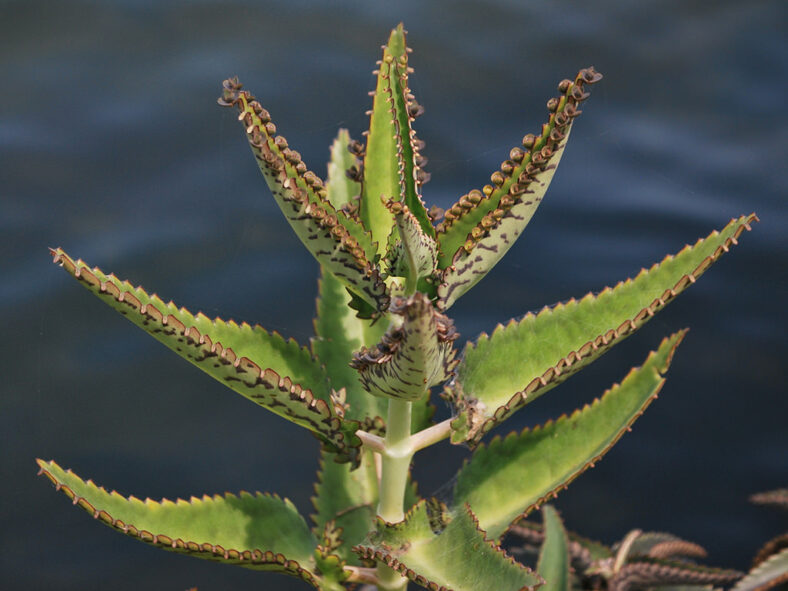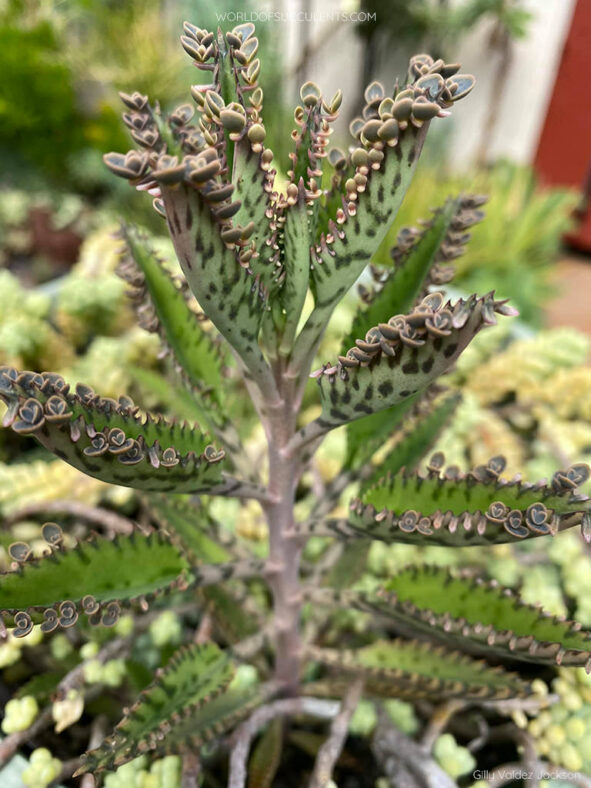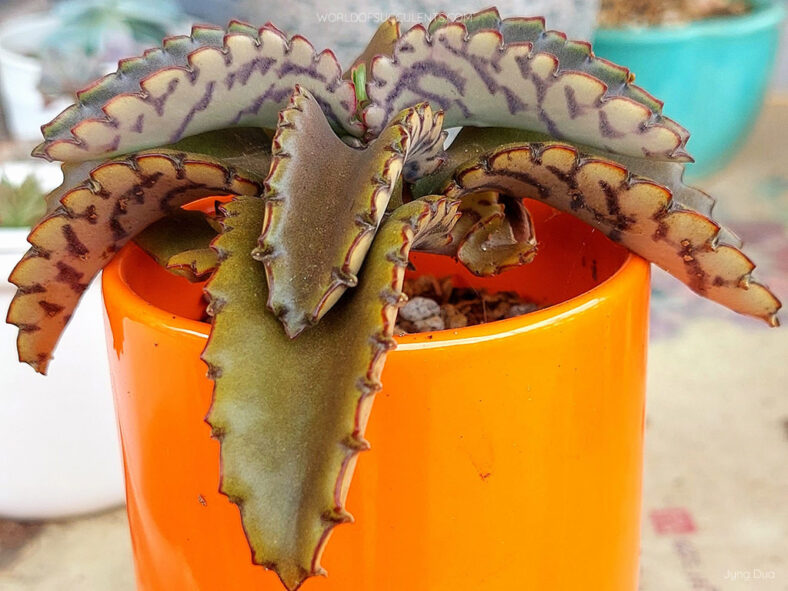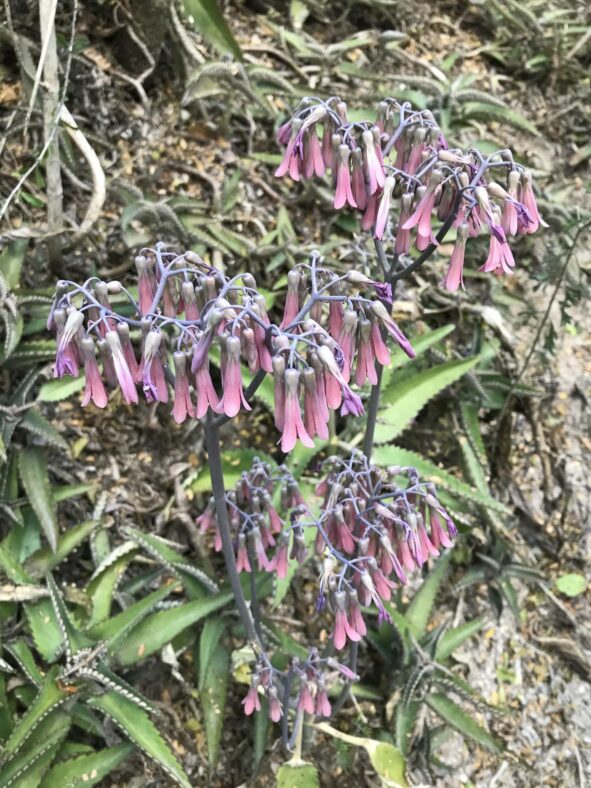Kalanchoe daigremontiana is often confused with Kalanchoe laetivirens or Kalanchoe × houghtonii. However, certain features can help distinguish them. Kalanchoe daigremontiana has purple bands on the undersides of its leaves, while Kalanchoe laetivirens has completely green leaves. Kalanchoe × houghtonii, on the other hand, has narrower leaves.
Scientific Name
Kalanchoe daigremontiana Raym.-Hamet & H. Perrier
Common Name(s)
Alligator Plant, Devil's Backbone, Maternity Plant, Mexican Hat Plant, Mother of Thousands
Synonym(s)
Bryophyllum daigremontianum
Scientific Classification
Family: Crassulaceae
Subfamily: Sedoideae
Tribe: Kalanchoeae
Genus: Kalanchoe
Etumology
The specific epithet "daigremontiana" (pronounced "day-ee-gree-mon-tee-AH-nuh"), erected in 1914, honors Madame and Monsieur Daigremont, then members of the Botanical Society of France.
Origin
Kalanchoe daigremontiana is native to southwest Madagascar. It grows in open woods, on sandstone or limestone in the Fiherenana River valley and Androhibolava mountains. This species has been introduced to various tropical and subtropical regions.
Description
Kalanchoe daigremontiana, also known as Bryophyllum daigremontianum, is a succulent plant with brownish, unbranched stems that bear opposite, evenly spaced leaves. It is highly variable in the size and shape of leaves and the size and color of flowers. The stems can be erect or decumbent, growing up to 3 feet (1 m) tall and 0.8 inches (2 cm) in diameter. The leaves are triangular to lance-shaped and have notched margins with numerous bulbils borne in the notches. They can measure up to 8 inches (20 cm) long and 1.4 inches (3.5 cm) wide and are attached to the stem by a petiole up to 2 inches (5 cm) long. The color of the leaves ranges from dark green and pinkish-green to purplish-green, and they have purple-blotched undersides.
During the winter, mature Kalanchoe daigremontiana produces hanging, bell-shaped flowers with green or purplish calyx and pink to lavender corolla. The flowers can reach a length of 0.8 inches (2 cm) and appear in lax, many-flowered, branched clusters. This plant is monocarpic, which means it will die after flowering.
Hybrids of Kalanchoe daigremontiana

How to Grow and Care for Kalanchoe daigremontiana
Light: Kalanchoe daigremontiana grows best in full sun but usually appreciates some partial shade during the hot summer days. When growing indoors, place it near a window with indirect sunlight. If it does not receive enough light, it may stretch.
Soil: The plant needs soil that drains well and does not like "wet feet." A commercial potting mix for succulents will work well.
Temperature: Kalanchoe daigremontiana thrives in heat and humidity but cannot handle frosts. It grows best in USDA Plant Hardiness Zones 9b to 11b, with average minimum winter temperatures ranging from 25°F to 50°F (-3.9°C to 10°C).
Watering: From spring to fall, water the plant thoroughly, but let the soil dry between waterings, as overwatering may cause stem rot. Reduce water during winter and only water it enough to prevent the leaves from shriveling.
Fertilizing: To ensure the plant has the nutrients it needs to thrive, fertilize it occasionally during the growing season with a balanced fertilizer. Dilute the fertilizer to half or quarter strength and apply it every two weeks.
Repotting: The plant thrives better when frequently repotted. For optimum growth, repot it every two years in spring, using a larger pot than you previously used.
Propagation: Kalanchoe daigremontiana can be easily propagated by plantlets that develop along the margins of the leaves. Spring is the best time to separate the plantlets.
Learn more at How to Grow and Care for Kalanchoe.
Toxicity of Kalanchoe daigremontiana
Kalanchoe daigremontiana is not toxic to people but should be kept away from pets because, if consumed, it may cause vomiting, diarrhea, and heart arrhythmias.
Links
- Back to genus Kalanchoe
- Succupedia: Browse succulents by Scientific Name, Common Name, Genus, Family, USDA Hardiness Zone, Origin, or cacti by Genus
Photo Gallery
Click on a photo to see a larger version.


